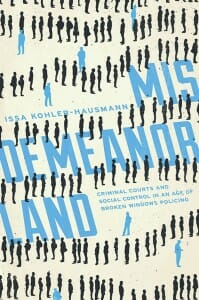Misdemeanorland
 By the early 1990s, misdemeanor arrests began to outpace felony arrests in New York. Now its most common criminal-justice encounters are for misdemeanors — not more serious felonies — and the most common outcome is not prison, according to Issa Kohler-Hausmann ’00. Kohler-Hausmann, author of Misdemeanorland: Criminal Courts and Social Control in an Age of Broken Windows Policing, an associate professor of law and sociology at Yale University, asserts in her book that this rise in misdemeanor arrests is largely due to the broken windows policing model, which contends that more serious crimes will be avoided if police enforce sanctions for low-level offenses.
By the early 1990s, misdemeanor arrests began to outpace felony arrests in New York. Now its most common criminal-justice encounters are for misdemeanors — not more serious felonies — and the most common outcome is not prison, according to Issa Kohler-Hausmann ’00. Kohler-Hausmann, author of Misdemeanorland: Criminal Courts and Social Control in an Age of Broken Windows Policing, an associate professor of law and sociology at Yale University, asserts in her book that this rise in misdemeanor arrests is largely due to the broken windows policing model, which contends that more serious crimes will be avoided if police enforce sanctions for low-level offenses.
In Misdemeanorland, Kohler-Hausmann offers a look at the people whose lives are surveilled by New York City’s lower criminal courts, drawing upon fieldwork, interviews, and analysis. She argues that, under broken windows policing, lower courts have mostly adopted a managerial role in which monitoring and control outside of the courtroom dominate. Although media attention often falls on felony convictions and mass incarceration, Kohler-Hausmann points out that a significant number of people are subjected to police hassle and court scrutiny, even though about half of these cases lead to some form of dismissal.
Kohler-Hausmann writes: “I conclude by arguing that the study of mass misdemeanors — like that of mass incarceration — ultimately points out larger political questions about what role we, as a democratic society, will countenance for criminal justice in establishing social order.”
Published in the Fall 2018 issue




Comments
No comments posted yet.